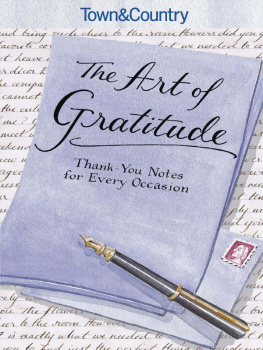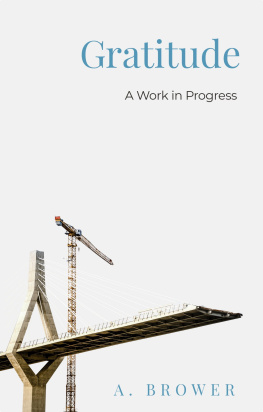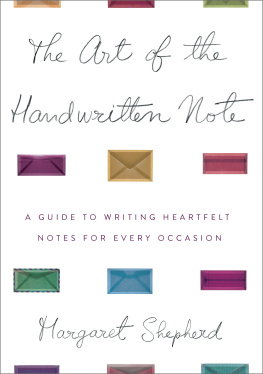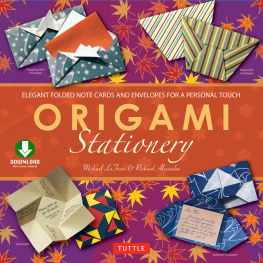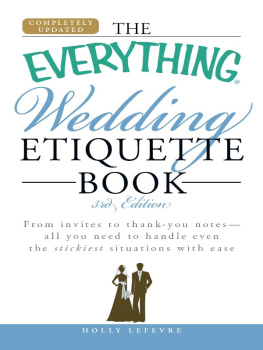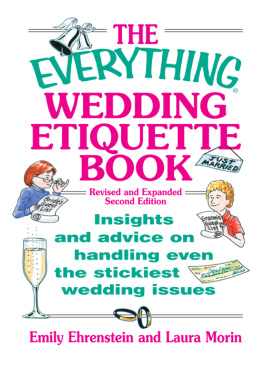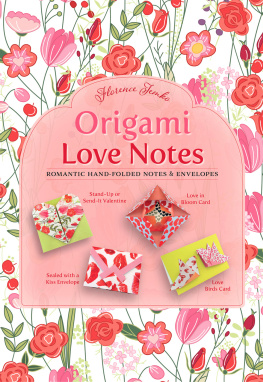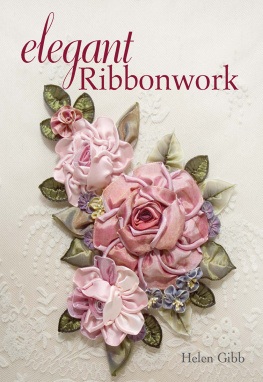Town&Country
The Art of Gratitude
Thank You Notes for Every Occasion
Caroline Tiger
ILLUSTRATIONS BY TANIA LEE
HEARST BOOKS
A division of Sterling Publishing Co., Inc.
New York / London
www.sterlingpublishing.com
Copyright 2008 by Hearst Communications, Inc.
All rights reserved.
Designed by Celia Fuller
Library of Congress Cataloging-in-Publication Data
Town & country, the art of gratitude : thank-you notes for every occasion from the editors of Town & country.
p. cm.
Includes bibliographical references and index.
ISBN-13: 978-1-58816-727-9 (alk. paper)
ISBN-10: 1-58816-727-5 (alk. paper)
1. Thank-you notes. I. Town & country. II. Title: Town and country, the art of gratitude. III. Title: Art of gratitude.
BJ2115.T45T69 2008
395.4dc22
2007045907
10 9 8 7 6 5 4 3 2 1
Published by Hearst Books
A Division of Sterling Publishing Co., Inc.
387 Park Avenue South, New York, NY 10016
Town & Country and Hearst Books are trademarks of Hearst Communications, Inc.
www.townandcountrymag.com
For information about custom editions, special sales, premium and corporate purchases, please contact Sterling Special Sales Department at 800-805-5489 or specialsales@sterlingpublishing.com.
Distributed in Canada by Sterling Publishing
c/o Canadian Manda Group, 165 Dufferin Street
Toronto, Ontario, Canada M6K 3H6
Distributed in Australia by Capricorn Link (Australia) Pty. Ltd.
P.O. Box 704, Windsor, NSW 2756 Australia
Printed in USA
Sterling ISBN 13: 978-1-58816-727-9
ISBN 10: 1-58816-727-5
SPECIAL THANKS
Id like to thank my mother and father, Jane and Arthur Tiger, for making sure I had personalized notecards from a very young age on which to compose my thank-you notesand for giving me so much for which to be thankful. Id also like to thank my English and writing teachers over the years for inspiring a love of reading and writing that fuels my prolificacy with notes and otherwise.
TABLE OF CONTENTS
by Pamela Fiori
I receive all kinds of inventive e-cards and e-vites; some as sophisticated as high-budget movies, complete with soundtracks, animated penguins, and rolling credits at the end. My e-mail inbox serves as storage for these and for the dozens of thank-you e-mails that dribble in after I throw a party or sent out a just-because gift. While I salute the creators of these mesmerizing confections and the thoughtfulness behind the thank-you e-mails, I lament that we are chipping away at civilized discourse.
Heres why: When a note is written by hand, more than words are imparted. Consider that each persons handwriting is different; like a hand-hooked rug or a needlepoint sampler, each note bears the mark of its maker. Now, compared to an e-mail where a sender chooses Helvetica or some other font used by millions around the world, you can see, feel, and even smell the difference. By selecting the paper, taking a pen in hand, thinking about what shes going to write, and then connecting pen with paper, a person sends a piece of herself as she was at the moment of the writing. This type of communication forges stronger and more meaningful relationships than those attempted via ephemeral modes such as e-mail or texting.
When you write a thank-you note, you communicate that you have taken time out of a busy dayand our days are only growing busierto stop and think about why you are grateful. Correspondence transmitted via screenscell phone, PDA, or computeris instantaneous and impersonal, with no guarantee that the sender is even who she says she is. The exchange feels more like a transactionand thats why, when I receive an e-card, I daydream about beautiful stationery and fountain pens forging a firm, unwavering line.
Its only natural that the democratization of technology would lead to what alarmists have termed a thank-you note crisis. One hears horror stories of grade-school children who dont even know how to address an envelope. Its certainly up to the older generations to impart the importance of writing thank-you notes by hand, but theres really no need for an alarm. Once someone has her own supply of stationeryand once she sends a letter and receives one in returnshell be hooked.
Theres no denying the selfish aspects of sending a handwritten noteits as pleasing for the sender as it is for the recipient. The extravagant paper use might also come into play, but theres no reason to label yourself a tree-killer when there are so many eco-friendly papers in the marketplace. The number of choices continues to grow as consumers become more environmentally aware. Consider limiting your stationery suite to just notecards and letter paper, a perfectly respectableand even admirablecollection in this technology-centered age.
Let the guidelines set forth in the pages ahead act as your handbook and inspiration. Chapters will discuss your writing tools, the writing basics, and then into your thank-you occasionsweddings, gifts and social occasions, for condolences, from children and teenagers, and business correspondence. Sample letters are provided for you to copy or from which to borrow phrases and ideas.
Thank-you notes arent only for official occasions, such as wedding gifts or after being hosted at someones beach house for the weekend. The best thank-you notes come from those impromptu bursts of gratitudedont keep these to yourself. Pull out a fresh sheet of creamy paper crowned by an elegant monogram, and steal a contemplative moment to think about and appreciate what the recipient of the note means to you.
When you set those thoughts down on paper and drop the note in the post, you will have the chance to revel in the delicious secret that someone out there is going to get her mail in a few days and rifle through the bills and catalogs to find this handmade giftthis instant day-brightener. Who could resist?
CHAPTER 1
Your Tools
Y OUR CHOICE OF PAPER, FONT, and language (formal or informal) projects a certain image. Before you select a tool, pause and think about the kind of impression you want to make. Especially because handwritten notes are brief, every detail you offer is a clue to be interpreted. Your thank-you note is expressive on several levelsthrough its tactile and aesthetic qualities and also through the language you use. Think about what you want to say when you choose your tools: your paper, your printing process, your stationery design, and even your pen.
The Stationery Suite
In this book, we only concern ourselves with the thank-you letter, which is traditionally written on a simple, monogrammed piece that appears as a staple in ones stationery suite or wardrobe. To a modern-day reader, that old-fashioned phrase might sound odd. Judith Martin aka Ms. Manners quips in her own witty way that when she first heard the words stationery wardrobe, she thought it meant dresses that didnt play the trick of looking too short one year and too long the next and that didnt capriciously change their fit throughout the years. Of course, that would be a stationary wardrobe. A stationery wardrobe refers to the tasteful menagerie of letter paper, note cards, and envelopes that you might find in the writing desk of the most well-appointed lady or gentleman. Its customary to have formal cards, informal fold-over cards, and flat cardsall with matching envelopes; plus white half-sheet paper with engraved monograms; as well as large single sheets with the house address engraved at the top for the use of everyone in the house, including guests.
The details of some traditional stationery components:
Formal letter sheets (5 x 7): Traditionally white or ecru notepaper made from 100 percent cotton fiber folded vertically, engraved with your monogram, your name only, your address only, or plain. Used for extending and replying to a formal invitation and for writing condolence letters. Use a pen with black ink for a condolence letter.

